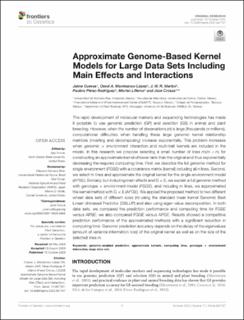| dc.contributor.author | Cuevas, Jaime | |
| dc.contributor.author | Montesinos-Lopez, Osval A. | |
| dc.contributor.author | Martini, J.W.R. | |
| dc.contributor.author | Perez-Rodriguez, Paulino | |
| dc.contributor.author | Lillemo, Morten | |
| dc.contributor.author | Crossa, Jose | |
| dc.date.accessioned | 2020-12-01T06:25:07Z | |
| dc.date.available | 2020-12-01T06:25:07Z | |
| dc.date.created | 2020-11-30T13:34:40Z | |
| dc.date.issued | 2020 | |
| dc.identifier.issn | 1664-8021 | |
| dc.identifier.uri | https://hdl.handle.net/11250/2690362 | |
| dc.description.abstract | The rapid development of molecular markers and sequencing technologies has made it possible to use genomic prediction (GP) and selection (GS) in animal and plant breeding. However, when the number of observations (n) is large (thousands or millions), computational difficulties when handling these large genomic kernel relationship matrices (inverting and decomposing) increase exponentially. This problem increases when genomic × environment interaction and multi-trait kernels are included in the model. In this research we propose selecting a small number of lines m(m < n) for constructing an approximate kernel of lower rank than the original and thus exponentially decreasing the required computing time. First, we describe the full genomic method for single environment (FGSE) with a covariance matrix (kernel) including all n lines. Second, we select m lines and approximate the original kernel for the single environment model (APSE). Similarly, but including main effects and G × E, we explain a full genomic method with genotype × environment model (FGGE), and including m lines, we approximated the kernel method with G × E (APGE). We applied the proposed method to two different wheat data sets of different sizes (n) using the standard linear kernel Genomic Best Linear Unbiased Predictor (GBLUP) and also using eigen value decomposition. In both data sets, we compared the prediction performance and computing time for FGSE versus APSE; we also compared FGGE versus APGE. Results showed a competitive prediction performance of the approximated methods with a significant reduction in computing time. Genomic prediction accuracy depends on the decay of the eigenvalues (amount of variance information loss) of the original kernel as well as on the size of the selected lines m. | en_US |
| dc.language.iso | eng | en_US |
| dc.relation.uri | https://www.frontiersin.org/articles/10.3389/fgene.2020.567757/full | |
| dc.rights | Attribution-NonCommercial-NoDerivatives 4.0 Internasjonal | * |
| dc.rights.uri | http://creativecommons.org/licenses/by-nc-nd/4.0/deed.no | * |
| dc.title | Approximate genome-based kernel models for large data sets including main effects and interactions | en_US |
| dc.type | Peer reviewed | en_US |
| dc.type | Journal article | en_US |
| dc.description.version | publishedVersion | en_US |
| dc.source.volume | 11 | en_US |
| dc.source.journal | Frontiers in Genetics | en_US |
| dc.identifier.doi | 10.3389/fgene.2020.567757 | |
| dc.identifier.cristin | 1854161 | |
| dc.relation.project | Norges forskningsråd: 267806 | en_US |
| dc.source.articlenumber | 567757 | en_US |
| cristin.ispublished | true | |
| cristin.fulltext | original | |
| cristin.qualitycode | 1 | |

